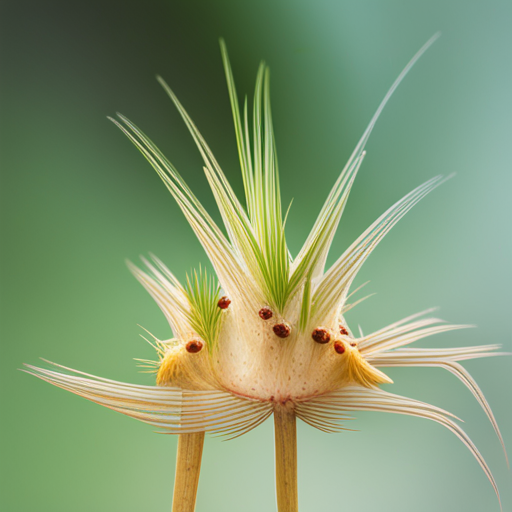Spider mites are minuscule arachnids that thrive in warm and moist environments, often infesting cat palms.
These tiny creatures pose a significant threat to both plants and cats. When infesting cat palms, they feed on the plant’s sap, leading to yellowing, wilting, and even death of the leaves.
In cats, spider mites can cause anemia and skin irritation, and in severe cases, they can be fatal. Signs of infestation on cats include red or brown dots on the skin, dry and brittle fur with missing patches, black specks on the fur (mites’ feces), and excessive itching or scratching.
To effectively manage spider mites on a cat palm, it is recommended to maintain a clean environment and employ natural insecticides such as neem oil or eucalyptus oil. Additionally, consulting with a veterinarian for specific treatment options is essential.
In order to prevent spider mite infestations on cats, regular nail trimming, proper coat hygiene, and supervision during outdoor activities are advised. Should a cat become infested, it is important to keep them away from the infested area and employ natural insecticides. Seeking veterinary guidance for appropriate treatment is imperative.
Contents
- 1 Our Highlighted Points
- 2 Spider Mites on Plants
- 3 Signs and Symptoms in Cats
- 4 Prevention and Treatment
- 5 Frequently Asked Questions
- 5.1 Can spider mites on a cat palm spread to other plants in the vicinity?
- 5.2 Are spider mites more common in indoor or outdoor cat palms?
- 5.3 Can spider mites on a cat palm be transferred to humans?
- 5.4 How long does it take for spider mites to infest a cat palm?
- 5.5 Are there any natural predators of spider mites that can be introduced to control their population on cat palms?
Our Highlighted Points
- Spider mites are tiny arachnids that can infest cat palms and cause damage to both plants and cats.
- Spider mites feed on the plant’s sap, leading to yellowing, wilting, and death of the leaves.
- In cats, spider mites can cause anemia and skin irritation, and in severe cases, they can be fatal.
– To manage spider mites on cat palms, it is recommended to maintain a clean environment and use natural insecticides like neem oil or eucalyptus oil.
Spider Mites on Plants

Spider mites, tiny creatures that thrive in warm, moist environments, can infest various plants, including cat palms, and cause damage by sucking sap from leaves, leading to yellowing, wilting, and death of the plants.
Spider mite infestation can be a significant problem for plant owners, as these pests reproduce rapidly and can quickly spread throughout the plant.
Controlling spider mites requires prompt action to prevent further damage. One method of controlling spider mites is by using a powerful hose to spray the affected plants, dislodging and removing the mites.
Chemical insecticides can also be effective in eliminating spider mites, but care must be taken to follow the instructions and not harm the plant.
Alternatively, introducing predatory insects, such as ladybugs, can help control spider mite populations naturally.
Regular monitoring and early intervention are crucial in preventing widespread infestations and preserving the health of plants.
Signs and Symptoms in Cats

Signs and symptoms of infestation can be observed in felines. When cats are affected by spider mites, they may exhibit various signs indicating the presence of these tiny creatures. These signs include small red or brown dots on the skin, dry and brittle fur with missing patches, black specks on the fur (mites’ feces), and excessive itching or scratching.
If left untreated, spider mites can have long-term effects on cats, such as anemia and skin irritation. In severe cases, spider mites can even lead to the death of a cat.
To address this issue, treatment options should be considered. Keeping the cat away from the infested area, using natural insecticides like neem oil or eucalyptus oil, and seeking advice from a veterinarian are recommended measures to eliminate spider mites on cats and prevent further harm.
Prevention and Treatment

Prevention and treatment methods for spider mite infestations on cat palms involve maintaining good hygiene, utilizing natural insecticides, and seeking guidance from a veterinarian.
To prevent spider mites, it is important to regularly clean the cat palm and keep its environment free from dust and debris. Additionally, cat owners should ensure the cat’s nails are trimmed and their coat is kept clean to minimize the risk of mites being brought into the home.
When it comes to treatment, natural remedies can be effective in combating spider mites on cat palms. Natural insecticides such as neem oil or eucalyptus oil can be used to control the infestation. However, it is crucial to consult a veterinarian for specific treatment options tailored to the cat’s needs.
By following these preventive measures and seeking professional assistance, cat owners can effectively manage spider mite infestations on their cat palms.
Frequently Asked Questions
Can spider mites on a cat palm spread to other plants in the vicinity?
Spider mites on a cat palm can spread to other plants in the vicinity. To prevent infestation, ensure proper plant care, maintain a clean environment, and regularly inspect plants for signs of spider mites.
Are spider mites more common in indoor or outdoor cat palms?
Spider mite infestations on cat palms can occur in both indoor and outdoor environments. However, the frequency of infestations may vary. Symptoms of spider mite infestation on cat palms include yellowing and wilting of leaves.
Can spider mites on a cat palm be transferred to humans?
Spider mites on cat palms do not pose a direct health risk to humans. While they can be transferred through contact, they do not cause harm to humans. However, they can cause anemia and skin irritation in cats.
How long does it take for spider mites to infest a cat palm?
Cat palms are susceptible to spider mite infestations due to their warm and moist environments. Signs of infestation include yellowing and wilting of leaves. Spider mites feed on the sap of plants, causing damage and potential death.
Are there any natural predators of spider mites that can be introduced to control their population on cat palms?
Natural predators of spider mites, such as ladybugs and predatory mites, can be introduced to control their population on cat palms. Additionally, control methods for spider mites on cat palms include using natural insecticides and practicing good plant hygiene.

